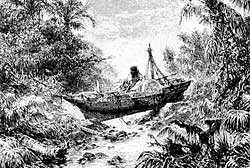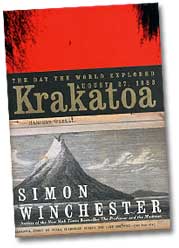 If someone had been reading history seriously, the littoral countries of the Indian Ocean would have had a tsunami early warning system in place by now.
If someone had been reading history seriously, the littoral countries of the Indian Ocean would have had a tsunami early warning system in place by now. The subduction of the Australian plate under the Sumatra coastline has caused frequent earthquakes and volcanic eruptions which have triggered tidal waves. Although it was not the greatest, the legendary eruption on 27 August 1883 of Krakatoa on the Sunda Strait between Java and Sumatra was the most recent big one.
After the Indian Ocean disaster in December, there will be renewed interest in Simon Winchester's 2003 book, The Day the World Exploded: Krakatoa. Winchester is a travel journalist and a master story-teller. He goes beyond just chronicling the disaster to analyse the historical conjunctions that Krakatoa represented.
In the second half of the 19th century, the telegraph had just been invented and installed in the Dutch East Indies. It was this communication technology and the advent of news agencies that for the first time in human history allowed information to be transmitted across the world through undersea cables. Before that, information could only travel as fast as the fastest steamboat. So, Krakatoa was the first global disaster in a globalising world.
The eruption also came as Charles Darwin's theory of evolution was being hotly debated, the Wallace Line that separated the Australian and Eurasian biodiversity domains and bisected the Indonesian archipelago had been discovered. There were unprecedented advances in scientific understanding and exploration of the natural world.
Krakatoa for the first time showed human beings that they were an interdependent species with shared vulnerabilities. Here was a disaster that for the first time was truly global in scale. Giant tsunamis raced across the oceans on 27 August 1883, killing 40,000 people. Three cubic kilometres of dust was pumped into the stratosphere and it swirled around the world for years giving rise to fiery sunsets and bringing down global temperatures. The sound of the eruption was heard as far away as Perth, Colombo and Manila, barometres in Washington DC and Hawaii detected the pressure changes caused by the explosion.
Winchester traces the effect the Krakatoa explosion had on the rise of Islamic fundamentalism in Java which inevitably turned into an anti-colonial movement that ultimately drove the Dutch out. There could be echoes of this in the aftermath of the Indian Ocean earthquake, not just in Indonesia.
 Indonesia is even more volatile at the beginning of the 21st century than it was in the late 1900s. The effect of the 26 December earthquake on the Aceh separatist war and on a post 9/11 resurgence of fundamentalism in Indonesia has yet to be seen. There is certainly geopolitical public relations at play in the unprecedented American and Australian military deployment in the rescue effort.
Indonesia is even more volatile at the beginning of the 21st century than it was in the late 1900s. The effect of the 26 December earthquake on the Aceh separatist war and on a post 9/11 resurgence of fundamentalism in Indonesia has yet to be seen. There is certainly geopolitical public relations at play in the unprecedented American and Australian military deployment in the rescue effort. The tsunamis affected another war-torn region: Sri Lanka. A cartoon in the Sri Lankan papers last week shows a soldier and guerrilla on a boat looking for the submerged territorial boundary that they have been fighting over for 20 years. In Aceh, Sri Lanka and southern Thailand last month's disaster exposed the complete absurdity of civil strife. And if there is one good that could come out of this, it would be that realisation among the belligerents.
But don't count on it. Look at what happened in Java after Krakatoa. Although the Dutch were generous with relief and rehabilitation, the disaster triggered an inexplicable rise in a religio-political anti-colonial jihad that culminated in the Banten Peasant's Revolt of 1888. Winchester concludes that the eruption of Krakatoa did indeed help ignite a political and religious movement that flared violently in Java. The post-Krakatoa assassinations of Dutch colonials by zealots clad in white robes can be seen as precursors to similar events like the bombing of the nightclubs in Bali in October 2002.
Although Krakatoa 120 years ago was a much more spectacular trigger event than the 9.0 magnitude earthquake that hit the other end of Sumatra last month, the tsunamis this time were more devastating. One reason is that there are more people living along vulnerable shores today. The tidal surges that Krakatoa unleashed were detected even in Europe, but in Sri Lanka the waves were not as high and there were only two known deaths in Galle. A news item from the Ceylon Observer of the sea's behaviour at Galle in 1883 quoted in the book is eerily similar to accounts from December 2004.
What is most frightening about Krakatoa is not its apocalyptic explosion but that Mt Toba and Mt Tambora also in Sumatra were several times bigger. Such cataclysmic displays of nature's raw power prove one thing: they will happen again. The only thing we can do is to be prepared to minimise the death and destruction. And pray.
Reviewed by Kunda Dixit


